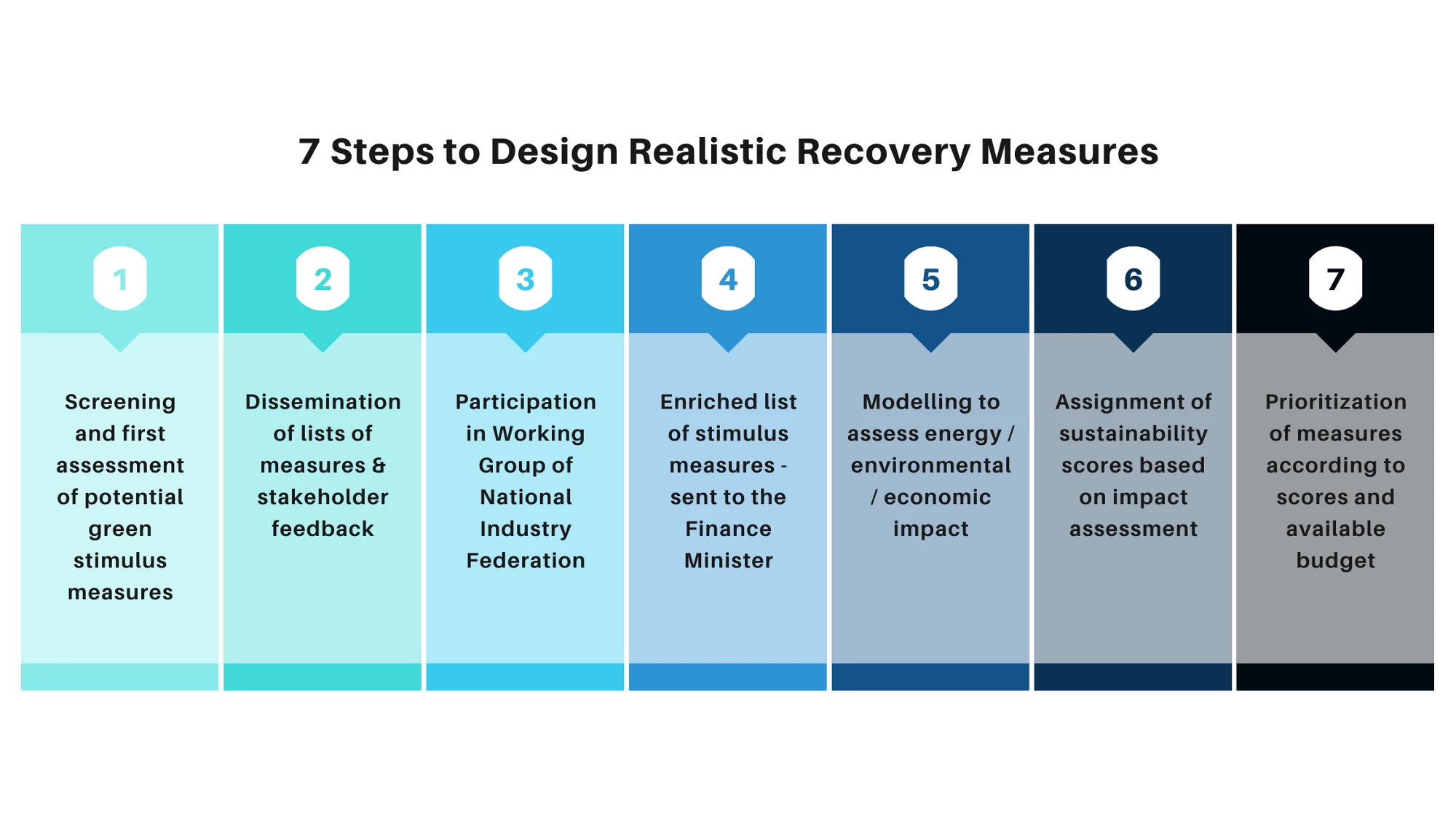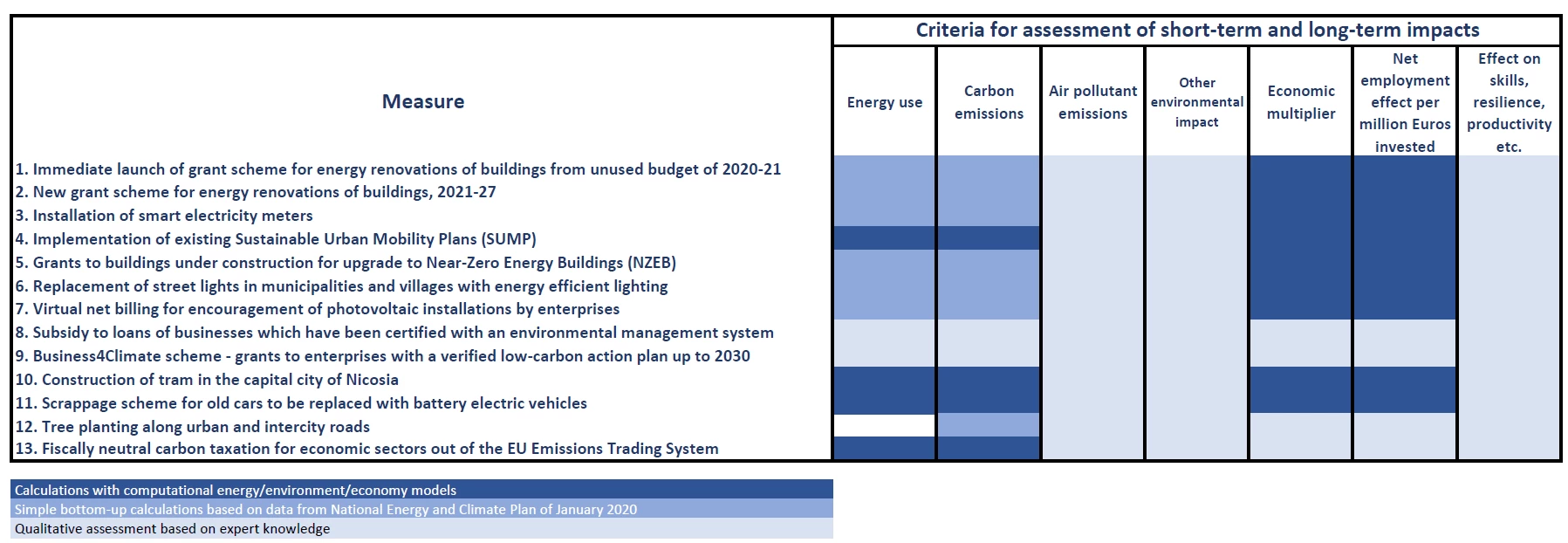 Panoramic view of Nicosia, Cyprus
Panoramic view of Nicosia, Cyprus
Despite the persistence of the COVID-19 pandemic, governments around the world are gradually transitioning from immediate relief to economic recovery. As countries move from generic declarations to specific national policies, there is a lot of groundwork to be done. Each country must identify the interventions which fit with its special conditions, resources, and needs. At the same time, leaders of international organisations have stressed the importance of adopting green economic stimulus policies to build greener economies more resilient to climate change, social unrest, and epidemics. During the last months, global economic support for relief and recovery from the pandemic has risen to very significant levels. However, the picture is mixed whether such stimulus measures conform with climate-compatible growth (CCG) and broader sustainability objectives.
In a study, we looked at whether a country-specific methodology could effectively screen for green recovery measures that respond to immediate needs while also building resilience. This post describes this process, along with guidelines that might be useful for other countries.
An opportunity for climate-friendly national projects
Stimulus packages need to be implemented quickly and to contribute to long-term development objectives. It is therefore useful to start from existing development plans, including climate change mitigation and adaptation plans, and to select projects that provide the largest benefits in terms of short-term stimulus and job creation.
Since April 2020, we have been applying such an approach to contribute to the debate on how to kickstart the economy of the Republic of Cyprus. The island state is a European Union member in the Eastern Mediterranean with a population of 1 million. The process to design a sustainable recovery package for Cyprus and provide it to policymakers for consideration has seven steps: screening existing plans for potential stimulus measures; gathering feedback from key stakeholders; participating in a working group on the green recovery; revising our list based on feedback; deciding how to assess the sustainability of stimulus measures; assigning scores to discover the most promising measures; and prioritising stimulus actions. More detail on each step is provided below.

1. Screening and preliminary assessment of potential green stimulus measures. In April 2020, we published a policy brief alerting policymakers to the need to ensure that economic stimulus measures enable the green transition. We identified a first list of measures that could be implemented within a short period and positively affect both employment and the environment. The list contained a qualitative evaluation of their impact; most of these estimates came from the Impact Assessment of the National Energy and Climate Plan of Cyprus, which was finalised in January 2020. A list of sustainability criteria was created, in line with a Sustainability Checklist developed by the World Bank.
2. Dissemination of a list of measures and stakeholder feedback. The initial list of green recovery measures was circulated to Ministries of Finance, Environment, Energy and Transport, European Commission officials, NGO representatives and academics. Stakeholders welcomed the proposed measures. They focused on the need to ensure a low administrative burden to allow fast implementation, and on the importance of aligning the proposals with early measures announced by the national government, in order to increase the relevance of our intervention.
3. Participation in working group of National Industry Federation. In mid-May 2020, after the first wave of the pandemic had been contained and public discussions started focusing on the ‘return to normality’, the national Federation of Employers and Industrialists (OEB) set up a working group on the green restart of the economy, in which we participated. OEB used our proposals as a starting point and supplemented them with additional measures targeted to enterprises.
4. Enriched list of stimulus measures sent to the Finance Minister. Based on the discussions in OEB’s working group, a revised list of green stimulus measures was prepared and sent by the Federation to the Finance Minister of Cyprus in mid-June 2020. Three types of measures were included: (i) Those which complemented general stimulus measures that had been announced by the Finance Minister some days before; (ii) measures that had already been foreseen in the National Energy and Climate Plan; and (iii) new measures that could be implemented quickly.
5. Identifying the appropriate methodology to assess impacts. For each measure we determined whether its energy, climate, and employment impact could be assessed through simple calculations or with the aid of models available for Cyprus (see table below). For some measures, such as energy renovations in buildings, models are not available, so that we have to rely on simple calculations. For other measures, such as those related to promotion of public transport or low-emission vehicles, existing models can calculate short- and long-term effects on energy consumption and emissions of greenhouse gases and air pollutants. Similarly, economic impacts can sometimes be modelled, but others require a qualitative assessment based, for example, on the percentage of domestic capital and labour inputs for the considered activity. Since our models are open-source, available to national authorities, and have already been used for preparing the National Energy and Climate Plan, national Ministries will be able to conduct any follow-up analysis if needed.
6. Assignment of scores for each sustainability criterion. Our work is currently at this stage. Having completed the energy and economic assessment of the measures, the results are transformed into scores for each one of the sustainability criteria outlined in Step 2. Composite scores for short-term and long-term impacts will be developed with appropriate weighting of each score.
7. Prioritisation of measures according to score and available budget. Based on the above-mentioned scores, and after filtering the measures to leave out some of them that may be inappropriate (e.g. due to high administrative burden or low likelihood for fast implementation), the proposed interventions will be prioritised, accounting also for budget availability.
Demonstrating the importance of green interventions
This approach is an example of how we could help policymakers design a stimulus that is aligned with long-term climate and sustainability objectives. Apart from the items described above, the proposal to be sent to the Finance Ministry could also include an aggregate assessment of the overall benefit to the economy and the environment from the implementation of these measures. This will be contrasted to the business-as-usual approach, which would provide economic stimulus without green preconditions. Such a comparison can highlight the importance of interventions that enable Climate Compatible Growth; although time and resources may be limited for massive green investment plans, the application of shovel-ready low-carbon projects can accelerate the deployment of green strategies, without any trade-off with short-term benefits. In preparation of the global climate conference (COP26) to be held in 2021, such an approach will also help governments that are updating their Nationally Determined Contributions to align their climate policies with economic stimulus measures.
Countries seeking guidance in designing their own green recovery plan may be inspired by our approach described here. However, the process will need to be adapted to the local context and involve the right actors. This is necessary to ensure the resulting proposal has the right credibility and ownership in the country.
Stay tuned for the results of our study (steps 6 and 7, above), expected towards the end of 2020.










Join the Conversation